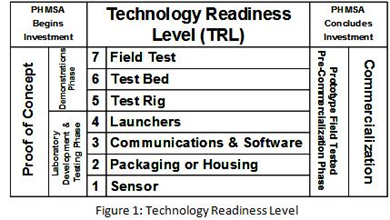|
Technology development through R&D is a critical factor in
expanding most if not all economic sectors of the United States and
the world. From new technologies, public utilities have become more
efficient and reliable, new medicines and medical equipment have
increased cure rates and life expectancy, and automobiles are designed
for greater safety. Many of these statements can be made for the oil
and gas industry and pipelines as well. Technology advances are making
it possible for the oil and gas industry to grow in tandem with the
nation’s energy needs while maintaining a cleaner
environment.1
The PHMSA Pipeline Safety R&D Program is fostering development
of new technologies so that pipeline operators can improve safety
performance and more effectively address regulatory requirements.
Technology development is expensive, slow, riddled with setbacks.
Research programs must divert significant resources in time, process
development and implementation with end users to get it right.
Sad but true, successful R&D rarely results in successful
technology transfer. A technology analyst and author Robert Cooper
cites studies indicating that only about 55 to 65 percent of new
products succeed after market launch. The attrition rate of
technologies in earlier stages of R&D is even greater. He cites
reports that “for every seven new product ideas, about four
enter development and only 1 succeeds.” These statistics are
for companies launching their own products of R&D2. The record of products involving a handoff between organizations,
say government contractor to manufacturer, is far worse. PHMSA
believes following these three rules of thumb can improve the
chances of success.
Rule No. 1—Plan for technology transfer from day one.
Rule No. 2—Involve end users (i.e. pipeline operators and
regulators) from day one.
Rule No. 3—Integrate potential service providers into the
plan as soon as possible.
Technology development should be transparent to potential end users.
This begins in the pre-solicitation phase at R&D Forums
sponsored by PHMSA and the pipeline industry. Consensus at these
events aligns technology needs with threats and integrates end users
into the design of required research milestones. At the pre-award
review, diverse sets of end users evaluate project merits and
further refine and align technology needs with identified threats.
After award, contractual milestones enable PHMSA to assess
technology development via a go or no-go approach with its partners.
Each quarter projects are evaluated or adjusted to address advances
or set backs and move the work along a logical path from proof of
concept to a pre-commercial technology.
PHMSA believes it’s important to convey and articulate the
technology story from proof of concept to commercialization.
Illustrating where public funds are initially applied in the
development and when they are no longer appropriate is very
important for a transparent program. PHMSA’s program is short
term meaning one to three years for deploying solutions. Some
technology research has taken as much as five years to
commercialize. Technology research investigating proof of concept is
completed before PHMSA and its partners invest in deployable
solutions. Figure 1 illustrates this discussion and highlights the
technology readiness level based on seven logical steps and split
between two different phases.

Technology demonstrations are specifically designed to ensure
research projects develop technologies that work under field
conditions. PHMSA uses demonstrations to validate the engineering
approaches utilized during the research scope for ultimate use in
the field. Once the majority of the laboratory develop and testing
is completed, demonstrations are held and can begin on a test rig
(pipe in a warehouse) then progress to a test bed (pipe buried in
the ground) and finally reach the field test stage where the
technology is applied to a real operational pipeline. Several
research projects awarded by PHMSA factor demonstrations as part of
project scopes.
Demonstrations are carried out with a detailed demonstration test
plan having strong input from both an industry advisory board and
the demonstration test participants. Researchers under contract with
PHMSA developing technology hold several informal demonstrations
throughout the work scope of projects. These informal demonstrations
increase the readiness level of technology to a point where formal
demonstrations are planned with multiple government and pipeline
stakeholders collaborating. PHMSA conducts formal events on a
periodic, not annual, basis.
1 American Petroleum Institute.
"State-of-the-Art Technology has Transformed the Oil and Natural Gas
Industry". 2001.
2 Robert G. Cooper. "Winning at
New Products: Accelerating the Process from Idea to Launch".
Cambridge: Perseus Publishing, 2001.
PHMSA R&D Success Stories – Commercialized
Technologies
Technology Demonstrations
PHMSA is coordinating with our researchers, end users and known
commercial vendors to commercialize technology and measure its impact.
The following section documents program progress and our collaborative
success since 2002.
|